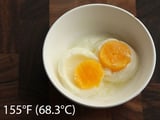Omelette, scrambled eggs etc. Are there any visual cues by which you could know if the eggs are "Safely cooked"?
-
3Hi Bar! Would you be willing to have a look at the title of your question to make sure it matches the question itself? To me, the title seems like you're asking for a temperature, and the question seems like you're asking how to tell if the eggs are cooked by what they look like in the pan. Also, are you asking only about dishes containing raw eggs which are then opened just before cooking? I'm sure it's my fault for mis-reading your question, so I apologize for that. I just wanted to check. Thanks!– Sue Saddest Farewell TGO GLCommented Feb 11, 2016 at 19:16
-
In the 1990s the US CDC estimated that 1 in 20,000 eggs had some level of salmonella contamination. So take comfort that even if your cooking process is off, you're still reasonably safe.– RobertCommented Feb 12, 2016 at 1:00
2 Answers
The FDA recommends 160°F (71°C) for dishes containing eggs. If you're scrambling eggs or making an omelette, as long as they're coagulated/solidified, they'll be safe.
The easiest way to confirm this is with sous vide eggs. For example, this Food Lab sous vide egg guide has 155°F, 160°F, and 165°F eggs:
which clearly show that the white won't be totally solidified until 160°F or even 165°F, even when cooked for an extended period of time.
(To be clear, those lower-temperature eggs are actually safe if cooked for sufficient time. The point here is just to show coagulation versus temperature, to demonstrate that when eggs cooking in a pan, you can use the solidity as a temperature indicator.)
-
FTR: Any restaurant serving me a soft boiled or poached egg that looks like the one on the 155F picture will not see me again as a customer. Commented Feb 11, 2016 at 16:43
-
@WillemvanRumpt This is something you'll really only see with sous vide eggs. If you actually soft-boil or poach, the water outside the egg is well above this temperature, so by the time the yolk reaches 155F, the white is well-cooked. You can still use sous vide as a shortcut, by cooking to a lower temperature then finishing in hotter water, but I don't think there's a risk of actually seeing a plain 155F egg in a restaurant, not claiming to be soft-boiled or poached, anyway.– Cascabel ♦Commented Feb 11, 2016 at 16:46
-
I recently watched some series featuring David Chang, and he poaches at 140F. I remember drooling after seeing the eggs :). And they will never get even close to 155F. Nice answer anyway, with better material and evidence than I presented, 1 up. Commented Feb 11, 2016 at 16:56
-
8Safety is not just a matter of temperature, but time and temperature. For example, an egg (cooked in water bath, i.e. sous vide) cooked at 57 Celsius (134.6 F) for 2 hours, will look like a raw egg, but in will be pasteurized and safe to consume.– moscafjCommented Feb 11, 2016 at 17:07
-
@moscafj: "Safety is not just a matter of temperature, but time and temperature": It appears frequently here in these kinds of questions, but I still tend to forget about the time factor. Thanks. Commented Feb 11, 2016 at 17:19
If safety is really your primary concern, boil the eggs long enough until the yolk starts to go blue, which should take around 10-12 minutes for a medium sized egg. They're pretty much as harmless as they can get then.
Other than that, any non-solid particle should technically considered to be a health hazard, if you use "health hazard" in the most liberal sense of the word.
Eggs can be consumed raw if you want, there's just a bigger chance anything bad in there might actually affect you. Note that "something bad present" does not equal "you'll get sick". It might make you sick, but merely presence does not equate getting sick. As you reduce cooking time, chances increase that some bacteria was still left alive, and thus your chances of consuming that bacteria increase, and thus by the power of numbers, your chances of you being affected increase.
In general, wait at least until the whites start to solidify, and you'll be good.
-
1The question seems to be asking about broken egg methods like scrambled or for omelets, not boiling eggs.– CatijaCommented Feb 11, 2016 at 17:19
-
Hence the " any non-solid particle should technically considered to be a health hazard" part. If you want to be absolutely safe, boil them, long and hard. If you're making an omelet or scrambled eggs, well, there's going to be runny stuff in there. At least, in my kitchen there is, and most restaurants I go to there is (which is of course a self selecting procedure). And the time-and-temperature rule is not going to apply, unless you're making two-hour-an-omelet omelets. Commented Feb 11, 2016 at 17:33
-
1But the beginning of your question is strictly about something the OP doesn't mention at all. I tend to avoid eggs at diners because most of them are over-cooked and taste of sulfur.– CatijaCommented Feb 11, 2016 at 17:40
-
Would it make a better answer if I strip that part, and just leave it at "Any non-solid particle...<the rest of the answer>"? Commented Feb 11, 2016 at 17:48



